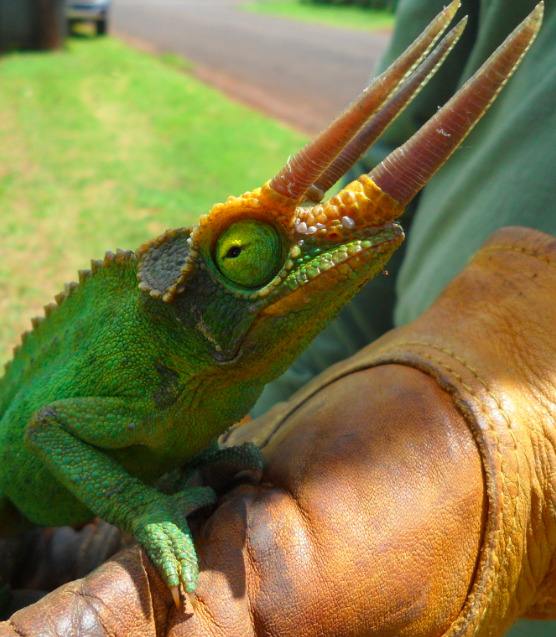Injurious Wildlife
Regulation

A Jackson’s chameleon caught on Kauai in 2013. Jackson’s chameleons are designated as injurious wildlife due to their impacts on native species, including snails. Photo credit: KISC
Under statutory authorities provided by Chapter 183D, Hawaii Revised Statutes, the Department of Land and Natural Resources maintains Hawaii Administrative Rules Chapter 124, which defines “injurious wildlife” as “any species or subspecies of animal except game birds and game mammals which is known to be harmful to agriculture, aquaculture, indigenous wildlife or plants, or constitute a nuisance or health hazard and is listed in the exhibit entitled “Exhibit 5, Chapter 13-124, List of Species of Injurious Wildlife in Hawaii…”
Under HAR 13-124-3 (d), no person shall, or attempt to:
- Release injurious wildlife into the wild;
- Transport them to islands or locations within the State where they are not already established and living in a wild state;
- Export any such species or the dead body or parts thereof, from the State.
Injurious Wildlife Export Permits
As authorized by the Board of Land and Natural Resources, the Division of Forestry and Wildlife may permit for export of injurious wildlife in certain situations, including research, educational display, or personal use (in very limited circumstances). Visit the Forestry & Wildlife Permits & Guidelines Page for details and to start a permit application.
No permits will be issued for commercial use. This policy avoids turning these harmful organisms into commodities that can be raised here in Hawaii and then exported to other states as part of the pet trade. The department often receives requests from individuals who would like to export injurious wildlife, especially Jackson’s Chameleon, for sale on the mainland, with the stated intent of also helping the environment by removing invasive species. While the intent is appreciated, these species are widespread and removing a small number of individuals for export would not provide a meaningful control method to benefit Hawaii’s environment. By preventing these species being used commercially, we hope to limit the interest in breeding these species for profit.
Injurious Wildlife Species
The current, official list of injurious wildlife in Hawaii can be found in HAR 13-124, Exhibit 5. Examples of injurious wildlife include:
BIRDS
- Bubulcus ibis (Cattle egret)
- All species in the family CETTIIDAE and associated allies (Warblers)
- All species in the family COLUMBIDAE. Except the domesticated races of pigeons listed in HAR section 4-71-2, Columba domestica and Columba livia (Doves and pigeons)
- Lonchura malacca (Mannikin or Munia, Black-headed Chestnut Mannikin)
- All species in the family MUSCICAPIDAE (Old World Flycatchers)
- Padda oryzivora (Sparrow, Java; Java Rice Finch)
- All species in the family PSITTACIDAE (Parrots)
- All species in the family PYCNONOTIDAE (Bulbuls)
- All species in the family STURNIDAE (Starlings, Mynas)
- All species in the family TIMALIIDAE (Old World Babblers)
- Tyto alba (Barn Owl)
- All species in the family ZOSTEROPIDAE (White eyes)
AMPHIBIANS/REPTILES
- All species in Family Agamidae (Agamid Lizards)
- All species in Family Anguidae (Anguid Lizards)
- All species in the genus Anolis (Lizards, Anole)
- All species in the Order Anura (Frogs)
- All species in the Family Chamaeleonidae (Chameleons)
- Gekko gecko (Gecko, Tokay)
- All species in the Family Iguanidae (Iguana, Green)
- All species in the genus Phelsuma (Gecko, Day)
- All Species in Family Scincidae (Skinks)
- All species in the suborder Serpentes, except Ramphotyphlops braminus and Pelamis platurus (All snakes)
- All species in Family Teiidae (Whiptails and Tegus)
- All species in the Order Testudines (All freshwater turtles and tortoises)
- All species in the subfamily VARANOIDEA (Monitor lizards and Gila monsters)
INVERTEBRATES
- Achatina fulica (Snail, Giant African)
- Aethina tumida (Small hive beetle)
- Apis cerana (Asian honeybee)
- Apis mellifera scutellata (Africanized honeybee)
- Corbicula fluminea (Clam, Asiatic)
- Darna pallivitta (Nettle caterpillar)
- Euglandina rosea (Snail, Cannibal)
- Gonaxis kibweziensis (no common name)
- Helix aspersa (Snail, European brown)
- Hypothenemus hampei (Coffee berry borer)
- Oryctes rhinoceros (Coconut Rhinoceros Beetle)
- All species in the genera: Pomacea, Pila, and Cipangopaludina (Snails, Apple)
- Solenopsis invicta (Red imported fire ant)
- Wasmannia auropunctata (Little fire ant)
- Varroa destructor (Varroa mite)
MAMMALS
- Herpestes javanicus (Small Indian Mongoose)
- All species in the order ARTIODACTYLA, except for game mammals identified pursuant to chapter 123 (Even-toed ungulates)
